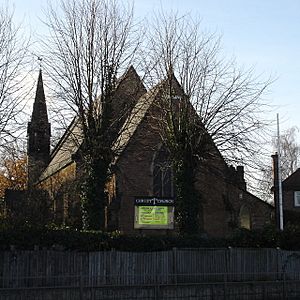Christ Church, Cinderhill facts for kids
Quick facts for kids Christ Church, Cinderhill |
|
|---|---|

Christ Church, Cinderhill
|
|
| 52°59′1.01″N 1°11′52.86″W / 52.9836139°N 1.1980167°W | |
| OS grid reference | SK 53996 43216 |
| Location | Nottingham |
| Country | England |
| Denomination | Church of England |
| History | |
| Dedication | Christ Church |
| Architecture | |
| Heritage designation | Grade II listed |
| Architect(s) | Thomas Chambers Hine |
| Style | Gothic Revival |
| Completed | 1856 |
| Construction cost | £2,306 |
| Administration | |
| Parish | Cinderhill |
| Deanery | Nottingham North |
| Archdeaconry | Nottingham |
| Diocese | Southwell and Nottingham |
Christ Church, Cinderhill is a historic parish church in Cinderhill, a part of Nottingham, England. It is part of the Church of England. The church is a Grade II listed building. This means it is officially recognized as a building of special historical and architectural importance, so it must be protected.
History of the Church
The church was built in 1856. It was designed by the architect Thomas Chambers Hine. The style of the building is called Gothic Revival, which was a popular style in the 1800s that copied the look of medieval castles and cathedrals.
Why was the church built?
Christ Church was built for the local coal miners and their families. These miners worked at the nearby Babbington Colliery, which was owned by a man named Thomas North. The church cost £2,306 to build, which was a lot of money back then.
At first, the church was a "chapel of ease." This means it was an extra church for people who lived too far away from the main parish church, St. Leodegarius Church, Basford.
Becoming its own parish
On June 19, 1856, the church was officially opened in a special ceremony called a consecration. This was led by the Bishop of Lincoln, the Rt. Revd. John Jackson.
In 1896, Cinderhill became its own separate district, and the church began to have its own chaplains. Later, in 1929, its official name was changed to ‘The District Chapelry of Christ Church Cinderhill’. A choir vestry, a room for the choir to get ready, was added to the building in 1902.


